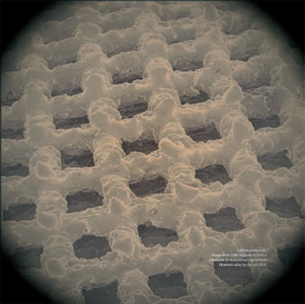Custom Manufacturing Grabs More of the RP&M Market, 2 in a Series
Both the practical and the funky benefit from rapid-manufacturing techniques.
Latest News
December 1, 2008
By Pamela J. Waterman
« Page 1 | 2
 |
Satisfying NicheManufacturing Needs
One of the early adopters of direct digital manufacturing is ScriptPro of Mission, KS, a manufacturer of automated pill-dispensing systems for pharmacies. The company has been using Stratasys FDM systems for several years, manufacturing selected parts for end-use in their machines. A popular model, the SP200, is expected to fill from 60 to 80 percent of most prescriptions.
ScriptPro’s dispensers can be the size of about four refrigerators side by side and include an electrical cabinet plus a control/monitor station. The system uses a robotic arm to pick up an empty pill vial, take it to a dispensing cell for filling, and place it on a conveyor. A label is applied, then the conveyor moves the vial into position in a collection station.
One of the challenges of designing and manufacturing these robotic dispensers is the need to accommodate the large variety of vial sizes (more than 50) available to pharmacies. Although most pharmacies use just a few sizes that vary in their sales demand, ScriptPro must be able to quickly assemble each customer’s dispenser configuration.
ScriptPro builds unique holders or bezels designed so that the user cannot put the wrong vial into the machine. Each SP200 dispenser has three vial receptacles and six bezels. The more basic styles are molded, but less common parts are produced on the Stratasys systems. The FDM process achieves such tight tolerances that little or no post-production work is required other than washing the parts before installation.
Being able to build the less common size bezels on an as-needed basis means savings on many levels. ScriptPro not only eliminates the need for custom-tooling (taking months each time) but keeps its inventory low, and can easily adapt to new styles.
Bringing Gamers’ Worlds to Life
Rapid manufacturing plays a role in having fun, too. Z Corporation has sold its full-color 3D printing systems to at least two companies involved in video-game worlds, including the companies involved in the phenomenally popular Rock Band 2 and World of Warcraft. For both situations, game enthusiasts create online characters (known as avatars) with unique feature combinations and order a 3D physical figurine that reflects the same design.
Measuring Time Savings with RP&M |
MTV Games and Harmonix produce Bandmate figurines based on avatars from the recently released Rock Band 2 game. Players visit rockband.com, create a model that reflects their own colorful rock-star persona, style, and musical instrument, then select from a number of different options to create a unique final character. Choices include 25 combinations of height and body style, various hair styles, about ten different facial expressions, male or female character, and even the ability to create a custom tattoo or band logo.
Harmonix takes the information from these selections and uses a complex algorithm to convert the data into a Z Corp. format. The process is quite automated, with the files only being examined for any copyright violations in the logo design. Finished figures range from about 3 in. to 6 in. tall, with all designs priced $69 each. Current manufacturing time is a week to ten days, and 40 orders were placed within the first three weeks of the new game (version 2) coming online. Harmonix expects to produce close to a thousand a month by the end of 2008, and expand to other online game environments.
FigurePrints takes a somewhat different approach to the creation of 3D characters based on World of Warcraft avatars. Any character pose is possible, and the FigurePrints designers perform minute inspection and design work to ensure that all parts are thick enough to print, the angles and positions of weapons and armor are aesthetically pleasing, and all elements have proper support. Finished characters can be as large as 8 in. tall; considered customizable art pieces, they cost $129.95. The company’s website states that the combination of overwhelming demand and hand craftsmanship currently limits them to taking orders on a monthly lottery basis.
Z Corporation says expanding the volume of this general concept depends on eventually simplifying the process for people who have intellectual property (IP). Companies are definitely recognizing the value of letting consumers interact with IP (think personalized M&Ms). Customized manufacturing is just an extension of this concept: the ability to take digital customized content, make it physical, and attach a monetary value to it.
More Info:
3D Systems
Rock Hill, SC
Adler Ortho Group
Milano, Italy
AlloSource
Centennial, CO
Arcam
Molndal, Sweden
EOS Novi, MI
FigurePrints LLC
Vancouver, BC
Harmonix Music Systems, Inc.
Cambridge, MA
Immersion
San Jose, CA
In’Tech Industries, Inc.
Ramsey, MN
Linear Mold & Engineering
Livonia, MI
Rapid Quality Manufacturing
Cincinnati, OH
Roland DGA
Irvine, CA
ScriptPro Inc.
Mission, KS
Soletec Systems Ltd.
Leicestershire, UK
Stratasys
Eden Prairie, MN
Wohlers Associates
Fort Collins, CO
Z Corporation
Burlington, MA
Contributing Editor Pamela J. Waterman is an electrical engineer and freelance technical writer based in Arizona. You can contact her about this article via e-mail sent to [email protected].
« Page 1 | 2
Subscribe to our FREE magazine, FREE email newsletters or both!
Latest News
About the Author
Pamela Waterman worked as Digital Engineering’s contributing editor for two decades. Contact her via .(JavaScript must be enabled to view this email address).
Follow DE





